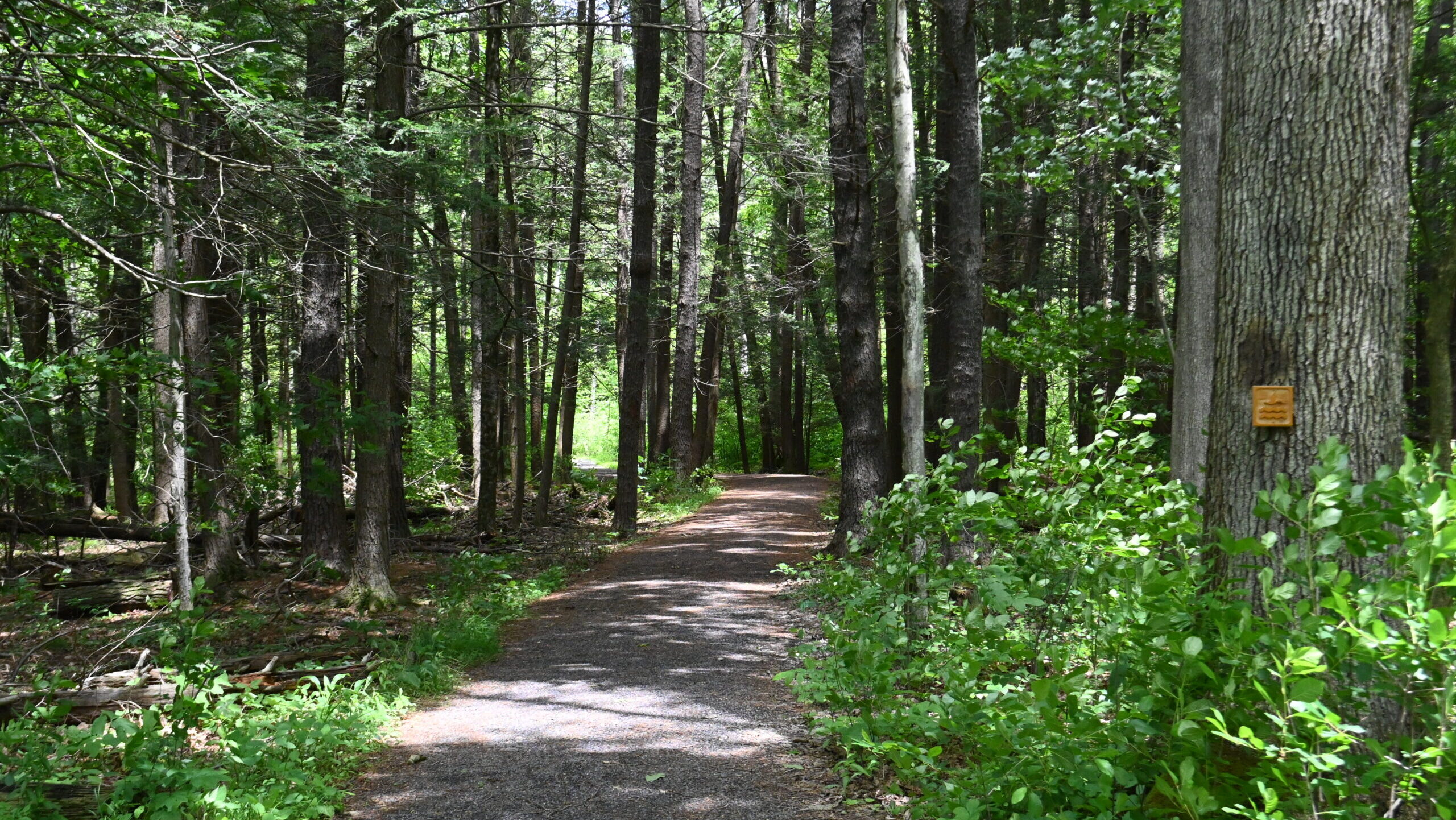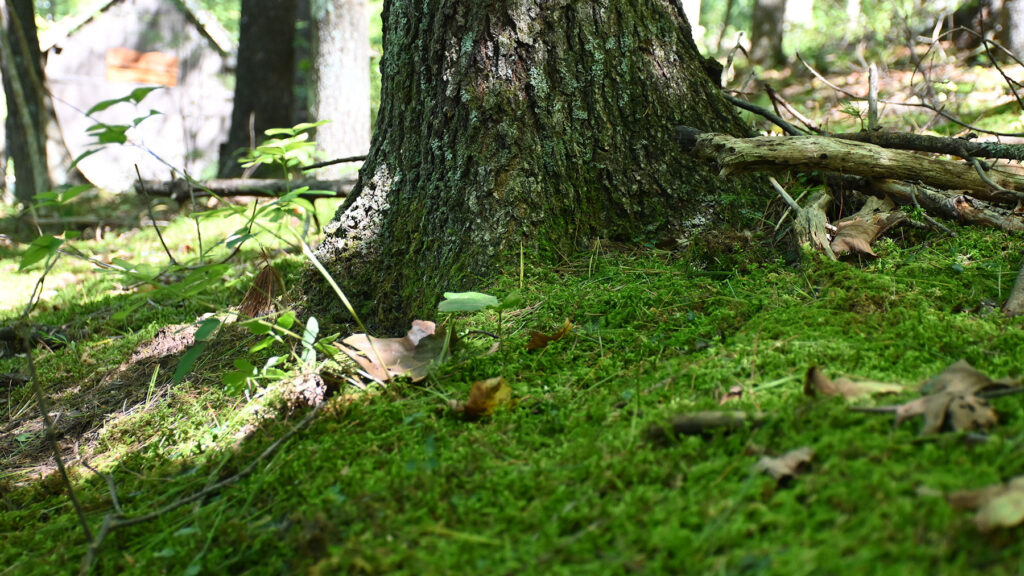
We’re shining a light on forests in this second blog post in a three-part series all about our local PA habitats. Read our September blog post, Grasslands, and check back in November for the third post in the series.
What is this habitat?
Forests, like grasslands, can be characterized using any number of names and definitions, but all of them have one thing in common, trees. Essentially, a forest is a complex ecosystem within a dense community of trees. They are the largest terrestrial ecosystems on the planet and thrive in many different climatic and topographic conditions. Depending on where you are in the world, you may encounter different forest types. Boreal forests can be found nearest to the poles and are home to many species of conifer. As you get closer to the equator, you’ll find temperate forests that tend to contain a mix of broadleaf deciduous and evergreen conifer trees. And closest to the equator, you can find subtropical and tropical forest types. The key characteristic of forests that makes them so valuable as an ecosystem is their vertical structure. The foundation for this structure is the forest floor, where nutrients and water are cycled, stored, and used by plants and animals. From here grows a herbaceous layer that supports non-woody plant species, an understory layer of shrubs and small trees, and a canopy layer composed of mature trees. Because each layer receives different amounts of light and water, we find different communities of plants and animals thriving at each level.
Why is it important?
Forests support people by providing countless ecosystem services: they supply natural resources like food and lumber; they regulate climate by storing carbon, cooling the air, and holding moisture; they produce oxygen and purify water; and they are loved for their cultural, recreational, and aesthetic value. Human influence over time has generally reduced the amount of forest land worldwide and affected the quality of many existing forests. Urban sprawl, invasive species, and overharvesting are a few of the factors that can negatively impact forest health. Though we still have a long way to go to improve our relationship with forests, we’ve learned a lot about the health and management of these ecosystems in recent years, and many groups are working hard for forests around the world. The Commonwealth of Pennsylvania is estimated to have over 16 million acres of temperate forest covering roughly 59% of its land area. Of that, about 29% is managed at the federal, state, or local level, and the remaining 71% is privately owned. That’s a lot of trees! This means that each and every one of us plays a role in supporting the forests that support us.

Where can we find this habitat locally?
The opportunities to explore forests in Pennsylvania are nearly endless! Penn State’s University Park campus is home to some lovely, publicly accessible forestlands. Stone Valley Forest in Huntingdon County, with its nearly 7,000-acre footprint, is home to miles of hiking trails, a recreation area with boat and cabin rentals, picnic areas, and the one and only Shaver’s Creek Environmental Center! Our center is one of many great ways to connect with a local forest through free programs, festivals and events, hiking trails, summer camps, and more. Over the mountain in Centre County, Shaver’s Creek also manages the Musser Gap Greenway, home to 90 acres of forest accessible by bike, walk, and public transportation.
On campus, The Arboretum at Penn State manages the 40-acre Hartley Wood, with trails connecting to parks, bikeways, and other local trail networks. Wintergreen Gorge in Erie, PA, is a beautiful example of a forest near another Penn State campus. Within an hour drive from Shaver’s Creek, you can explore Rothrock and Bald Eagle State Forests. If you’re outside of the Centre Region, look into one of the state’s 18 other forests or 124 state parks. There’s also the Allegheny National Forest to the west and the Delaware Water Gap National Recreation Area to the east.
Because Pennsylvania (which translates to “Penn’s woods”) has so much forest, most of its citizens are not geographically far from prime examples of the many forest habitats we have to explore, but this doesn’t always mean easy access. Barriers to exploring these ecosystems include location, experience, age, gender, race, and socioeconomic status. Luckily, we have many groups, from federal and state agencies to nonprofit organizations, working hard to improve access for every citizen of the commonwealth. Shaver’s Creek is likewise committed to continuously finding new ways to expand access to the outdoors in our community so that we all have the opportunity to connect with these important habitats.
Who relies on this habitat?
A beneficial habitat at all levels, forests support numerous species of wildlife across many taxa. As you walk along the forest floor, you may notice salamanders hunting insects among the logs and stones, sheltered by shade-tolerant flowering plants, such as Trillium. Look a little higher and you may notice a Hercules Beetle crawling up the trunk of a Pawpaw tree, looking for sap and tasty fruits. Look higher still and you may see a Broad-winged Hawk perched on the branch of a towering White Oak. These species aren’t restricted to these layers and, in fact, rely on the species above and below them for survival. The salamander and Trillium need the shade of the oak trees above to help them stay moist and protected from the sun. The Pawpaw and Hercules Beetle also need the shade provided by the White Oak and the additional nutrients and larval food sources added to the soil when the Trilliums become dormant for the summer. And the Broad-winged Hawks have a great vantage point from their nests, obscured by the Pawpaw below, to search for prey in the subsequent layers below. All of these elements are interconnected in a healthy forest ecosystem.
Shaver’s Creek is home to a number of resident animals that serve as educators and ambassadors of forest habitats. From our resident Tiger Salamander and Eastern Hercules Beetles in the Litzinger Herpetarium to our resident Broad-winged Hawk in our Klingsberg Aviary, you can come get an up-close look at these critical species firsthand. Visit on your own or stop in during a free program to learn all about them and more from our Wildlife Care Team. Forming deep connections with the species that rely on forests is just one way to begin to become a champion for these spaces.
What conservation actions can we take to support this habitat and related species?
Forests improve our lives in so many ways, and there’s plenty we can do to support them and ensure their health long-term. If you are part of the roughly 1-in-7 Pennsylvania households with privately owned forest, it is important to manage your land sustainably. If you’re not sure what that means or how to get started, there are many educational resources available to assist you. Some good places to start would be the James C. Finley Center for Private Forests at Penn State, Penn State Extension’s Forests and Wildlife team, or your county’s Service Forester (PDF).
If you don’t own any forest land, there are still plenty of impactful ways to help: avoiding invasive species when landscaping around your property, practicing Leave No Trace principles when recreating outdoors, and supporting conservation and access groups in your area are all great starting points. And, most importantly, you can always learn more about forests locally and globally by reading, exploring, and connecting with others. Why not start right here, at Shaver’s Creek Environmental Center? Happy trails!




